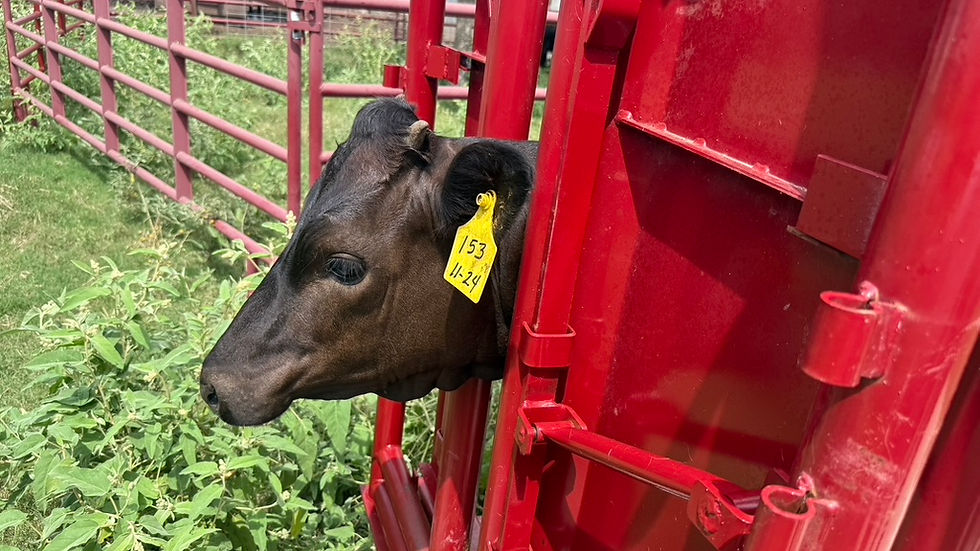Weaning Our Wagyu Calves: A Journey of Growth
- Becky Weise
- Jul 21
- 5 min read
Updated: Aug 4
Our Wagyu Weaning Process
Weaning is an essential part of cattle farming, particularly for breeds like Wagyu that are known for their high-quality meat. It involves separating calves from their mothers so they can stop relying on milk. We normally wean our calves by mid-June, but due to the rains, we could not do so until July 12.
This added time equals added stress for the mothers, who need recuperation time between calves. As we herd the calves through the chute, we weigh them. Keeping good records that include the weights of each calf provides us with valuable insights into their growth at each new stage of their lives.
When the day finally arrived, rain was still in the forecast. We managed to pen all but one of the calves who didn’t go into the pen - that rascally heifer. But missing a heifer is not as bad as missing a bully since we castrate all of the calves. The older bull-calves are, the more stress it induces on the calves. We prefer a life for our Wagyu calves that is as stress-free as possible.
Tagging is crucial for tracking their growth and health. It ensures that all calves are accounted for when we check them.

Moving Wagyu Calves to The Pietsch Place (Part of Weise Farms)
After deworming, tagging, and banding, we transported eight calves to our place in Warda. We call it the Pietsch Place because my Dad bought it from the Pietsch family. This 55-acre farm is part of Weise Farms, and it is special for its rich grazing pastures, which are perfect for our Wagyu calves transitioning away from their mothers.
The move was smooth. We called the other weaned calves from November with our special whistle and a bag of range cubes. All we had to do was rattle the bag, and the calves all went into the pen. Then we let the newly weaned calves out of the trailer into the pen with the ones who were used to being there. I think it helps them transition, and the older calves help them find their way around. It's a constant cycle.
After all of the cubes were eaten, we opened the pen to allow all of the calves to graze on the lush grass. Of course, the newly weaned calves walk the fenceline for several days as they call out for their mothers. At home, the mothers call for their babies. I have a soft spot in my heart for the mothers as they adjust to their empty nests and their full udders.

Challenges Faced During Weaning
It wasn’t all sunshine and rainbows during the weaning process. Just as we were getting into the swing of things, a sudden heatwave hit the area. We were sweating.
Fortunately, a refreshing rain shower followed the heat. It was nice to cool off, and we never stopped working. I had to move my paper records and clipboard inside the Mule so they wouldn't get wet. The change in temperature made our efforts in caring for them that much more effective. I don't think I ever remember a July as nice as this one.
Bringing Two Calves Back Home - The Cycle Continues
Raising Wagyu beef is a long and slow process, and the cycle never ends. Two of the calves that we took to the Pietsch Place in the fall were ready to be moved back home to our grass pen. This is the next step before moving them into the feed pen. This planned movement is all about making sure that each calf is right where they need to be when we need them. When one calf "graduates" from the feed pen, another one goes in. We like to keep two together at all times because they are herd animals, and it is not good to keep just one.
By using a gradual approach, we ensure a smooth transition that keeps stress levels low. Implementing a systematic feeding plan allows us to gauge when each calf is ready for the next phase. We keep records of birth dates, weights at different stages of their lives, and how long they have to be on feed before harvest.

Our Strategy for Raising Wagyu Calves
We try to wean around six months of age. That is the time when they start grazing the pastures at the Pietsch Place for a year. Then they are finished on our specialty Wagyu blend for around 300 days. By the time they are ready for harvest, they are around 30 months old. They know us well. They eat out of our hand. When they make their final ride, we always thank them.
We are constantly learning and improving our strategy following weaning. High-quality forage, minerals, and hay when needed ensure they receive all necessary nutrients. This step plays a significant role in their growth trajectory. But the secret is in the cubes. When you can train your cattle to range cubes, it makes working with them easy.
Consistency is key to having cows that are easy to work with. When the home place herd hears the Mule start up, they come running and bellowing. At the Pietsch Place, when they hear our truck and our special whistle, they run right into the pen, sometimes before we even get out of the truck.
Looking Ahead: Future Challenges and Opportunities
As we move further into summer, we will keep monitoring our Wagyu calves' growth. Each weaning season has its unique challenges, but it also presents more opportunities for our own knowledge and improvement. We maintain close communication with local agricultural experts to ensure we are implementing the best possible practices.
We are keeping a serious eye out for the "new world screw worm," which could be devastating to many animals. Please keep us and all farmers in your prayers.
We also aim to continue sharing updates with our readers about our farm operations. Keeping the community informed helps establish transparency and fosters a genuine connection to the experiences on the farm.
In summary, finally getting to wean our Wagyu calves was an accomplishment that required patience and adaptability. We look forward to seeing these calves thrive in the coming months as they progress towards becoming top-quality prime+ Wagyu beef.
Thank you for following along on this journey, and we hope you’ve enjoyed learning about our farm's operations!

$50
Product Title
Product Details goes here with the simple product description and more information can be seen by clicking the see more button. Product Details goes here with the simple product description and more information can be seen by clicking the see more button

$50
Product Title
Product Details goes here with the simple product description and more information can be seen by clicking the see more button. Product Details goes here with the simple product description and more information can be seen by clicking the see more button.

$50
Product Title
Product Details goes here with the simple product description and more information can be seen by clicking the see more button. Product Details goes here with the simple product description and more information can be seen by clicking the see more button.






























Comments